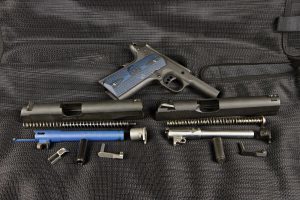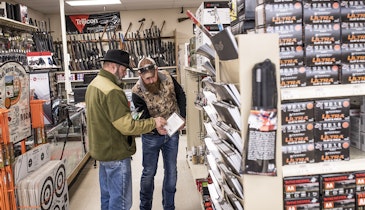Until recently, realistic force-on-force firearms training using Simunition equipment where opponents actually shoot at each other was only available to the military and law enforcement. Now, the company is making that same equipment available to select commercial ranges and instructors.
Not much increases stress levels in humans like being shot at. When bullets are flying, especially for the first time, that level of stress can wreak havoc on a student’s ability to think clearly and perform manual tasks efficiently. Law enforcement officers and war fighters learn through real-life experience that they can still perform under that kind of stress and prevail in a gunfight.
Making training as realistic as possible helps the student perform better in the real world, but actually getting shot at in training to increase stress levels would get people killed or injured. However, if the trainee could shoot at others and get shot at while avoiding the deadly consequences of using real ammunition, stress levels could be raised significantly, and the student could learn to operate a firearm more effectively.
In the 1980s, General Dynamics-Ordnance and Tactical Systems Canada developed a training round that could be fired from a real gun at human targets and not injure the person being shot. At first, Simunition equipment was available only to the military, but soon after, law enforcement adopted the system. Back then, with only rare exceptions, a non-sworn civilian could not obtain training using Simunition equipment, but that has recently changed.
In order for a commercial range or instructor to obtain the materials and equipment needed to provide Simunition training to civilians, a complete vetting process is performed. This is serious equipment used by professionals, so hobbyists and those interested in recreational gun use are still barred from Simunition sales. To be certified, the trainer or range must be in business and complete a training course in the safe use of Simunition equipment. The course is available online or at various locations around the United States.
Why Use It?
By putting trainees in a situation where stress is higher than on the square range, opponents actually shoot back, hits hurt and students learn to better control their fear response. When they have to move, make decisions and fight back against an opponent who is doing the same thing, skills developed on the square range are put to practical use. When that is done in a safe environment during training, it’s easier to put those skills into practice in the real world.
Schools offering that level of training stand out among the others as a place where a student can develop a higher skill level than is possible at places offering only square range training. If a school can do a better job of providing realistic training, it can attract more serious students who are willing to pay a greater amount for their training.
Range Expense
The least expensive way to obtain the training needed for approval to purchase Simunition equipment and supplies and to offer Simunition force-on-force training is to take the internet-based course that costs $70 per person. Of course, the best training comes with hands-on experience, which would require attending a Simunition on-site class that costs about $200. The class schedule and locations are listed on the company’s website.
It is expected that instructors receiving Simunition training already have the expertise to provide self defense shooting instruction, so the company instead concentrates on the safe use of Simunition equipment in training. Courses include information on the various Simunition cartridges available, how to convert a gun to fire Simunition cartridges, the use of protective equipment and how to design and conduct a force-on-force training scenario.
When designing a training scenario, the specific lesson to be taught must be kept in mind, and the scenario should be structured specifically to drive that point home. Shooters playing the role of aggressors can ruin a training exercise if they permit their egos to cause them to abandon their prescribed role.
According to Gunsite instructor John Hutchison, this does not mean that if the student makes a mistake that the role player should not shoot them to drive home the training point. If that happens, the student should repeat the scenario and perform it correctly so that he learns the lesson and leaves with a positive mindset.
“The role player needs to be just as committed to the student’s success as the instructor and not be in competition with the student, which is one of the problems with scenario training,” Hutchison said.
Getting shot with a Simunition marking round is not a pleasant experience and imparts a small amount of pain, like getting pinched, and it can leave a bruise that will be sore to the touch. But that small amount of pain — or the anticipation of it — increases the stress level, which is one of the benefits of force-on-force training. It helps to teach the student to operate effectively under stress and to control their fear.
Safety is of the upmost importance because the improper use of Simunition equipment could result in injury. While it can be fun, using Simunition equipment in force-on-force training is serious business and should not done for entertainment value. It is not a paintball game, and instructors should never let a training scenario turn into one.
The Necessary Gear
Converting a gun to fire Simunition cartridges is a simple and reversible process, so students can use their own guns as long as Simunition offers a conversion kit for that make and model. Once a conversion has been completed, the gun will not chamber a standard round. Instead, it will only chamber Simunition cartridges that are offered in 9mm, 5.56mm and .38 Special. Marking cartridges have a plastic projectile that is filled with a water soluble detergent-based substance that washes off clothing and surfaces.
Various colors — including white, orange, yellow, green, blue and red — are available so instructors can evaluate the effectiveness of hits on opponents from specific shooters.
Simunition offers not only marking rounds, but also a SecuriBlank line consisting of two versions — quiet and standard. These blanks are safer than a normal blank because they eliminate nearly all unburned propellant and ejected particles usually associated with blanks. Additionally, once a gun has been converted with the kit, a regular cartridge or a standard blank will not chamber.
For those situations when force-on-force training may be conducted in a place where leaving a mark (even if it is washable) is not wanted, Simunition offers cartridges that do not contain the marking compound. A small pain penalty is delivered when a student is hit, but a miss will not leave marking compound on surfaces.
To protect the student, Simunition offers approved protective equipment designed specifically for use with Simunition cartridges. Use of other equipment not tested or approved by Simunition is not allowed. When pressed for a ball-park figure of the minimum cost for a range to get set up to use Simunition equipment in training, the company estimated that a couple of conversion kits and two sets of protective gear would be needed, totaling $2,000 to $3,000.
Serious trainers are always looking for ways to make their instruction stand out compared to other classes. Providing force-on-force training using Simunition equipment is one way to do it.
Simunition Protective Equipment
Even though Simunition cartridges are designed not to impart permanent serious injury, the pain associated with getting smacked with a marker projectile helps to induce stress in trainees. However, a plastic projectile traveling approximately 500 feet per second can still injure someone if it hits a tender, vital spot like the eyes. Because of this risk, Simunition created several items of protective equipment to be worn by shooters — three of which are mandatory.
The first is one of two styles of headgear that include eye protection and cover the sensitive and tender skin of the head. A neck protector is also required to cover the throat, and the last is a groin protector which is worn outside the clothing. Male and female models are available.
While many who train with Simunition cartridges only wear these three items in addition to their regular clothing or uniforms, Simunition offers other protective garments, including arm protectors that cover the lower half of the arm, sleeves for the upper part and shoulders, a vest, short pants and gloves.
All the equipment has been tested and approved by Simunition to withstand hits from the company’s FX marking cartridges. While they do reduce the pain of a hit somewhat, they do not eliminate it all together.
Wearing all that equipment can be hot, and the more that is worn, the more restrictive the wearer’s movement becomes. So, there is a trade-off between pain reduction and training in the clothing that will be worn in the real world.
Gloves can be especially cumbersome to wear if they don’t fit correctly and the wearer is not used to manipulating their weapon or other equipment with them. For example, wearing ill-fitting gloves and trying to release a car’s seatbelt can be difficult. Although Simunition designed the headgear to minimize restriction of vision, peripheral vision is affected.
While some may look at these equipment characteristics as negatives, others consider them positive. For if the student can learn to operate effectively with restrictions imposed by protective equipment, he can probably operate even better without it in the real world.
Only equipment specifically designed by Simunition is approved for use with Simunition cartridges. Equipment is available only to those instructors who have completed the Simunition training and are approved by the company.
Simunition Conversion Kits
An advantage offered by Simunition is that students can use the same guns they carry every day. This means that once a student makes modifications to his particular carry gun, most, if not all, are retained on the training gun.
The benefit is obvious. If the student uses a gun he is not accustomed to during training, weapon manipulation skills may not be carried over into a real life and death conflict.
Simunition offers conversion kits for several different long guns and handguns, including M16/M4 variants; the HK416, the FN SCAR, the Beretta 92 and the Colt 1911, as well as some Glocks, SIGs, S&Ws and Walthers. Recently, Gunsite Academy conducted a class titled Active Shooter/Terrorist Response For Civilians where force-on-force training using Simunition equipment. For hands-on experience with Simunition equipment, the author participated and used a converted Colt Competition 1911.
Converting the stock gun was simple and straight forward. No special tools were needed and merely field stripping the gun before installing the conversion kit was all that was necessary. The kit consists of a 9mm magazine slide with three dot sights and many of the gun’s internals.
The barrel is painted bright blue and has an offset bore of about .30 caliber along with a bottlenecked chamber to accept bottlenecked Simunition 9mm cartridges. The feed ramp insert is needed to facilitate feeding into the offset bore and is easily pressed in place with finger pressure.
Once installed, the gun fires Simunition 9mm marking or blank cartridges. Operation is straight blowback, so barrel lug fitting is of no concern. Disassembly and conversion back to standard consists of merely field stripping the gun, removing the feed ramp insert and reassembling with the original parts.
Although recoil when using Simunition cartridges is different than that imparted by a standard cartridge, it was surprisingly close to that of a real round.







